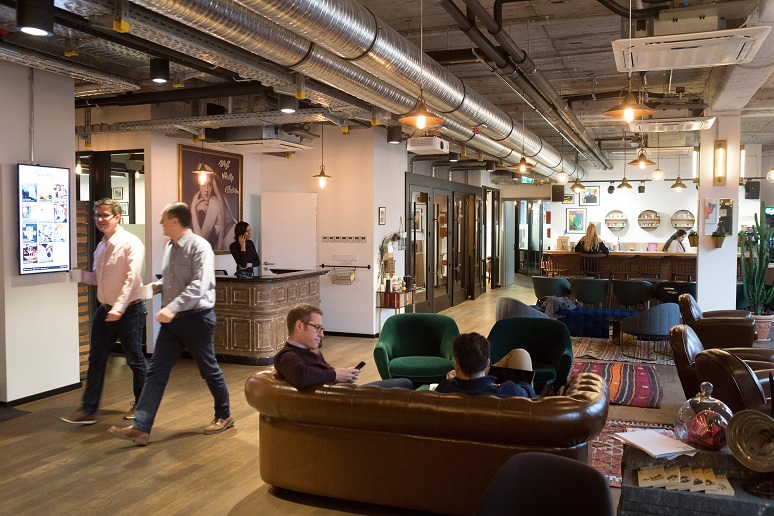While we've seen a lot of workplace trends come and go through the course of the pandemic, some are finding new life as we move towards the future of work. Though it might be a while before employees rush back into tiny huddle rooms en masse — unmasked and ready to collaborate — discussions around coworking and flexible workplace services have recently gained traction, and workplace leaders are once again exploring how these work options can help enable hybrid work in their organization.
Coworking Market Rebounds
The coworking and flexible workplace industry was hit hard as the use of these services plummeted during the pandemic. By real estate company
CBRE estimates, 144 flexible office providers reduced their real estate footprint by 12.2 million square feet across 42 U.S. markets. Looking at the numbers,
a 2020 Research and Markets report estimated that the global coworking spaces market declined from $9.27 billion in 2019 to $8.24 billion in 2020.
Flash forward to today, and industry analysts are now projecting that the coworking industry is not only rebounding but expanding.
Statista projects that there will be 41,975 coworking spaces worldwide by 2024, up from 19,421 in 2020.
Over the last several weeks, coworking and flexible work providers have made announcements, leaving the impression that the industry is on the move again. A couple of weeks back,
I shared the news that WeWork would be partnering with flexible workplace startup Upflex to create a global network of flexible workstations (approximately 800 from WeWork and 4,800 for Upflex). This came after
WeWork announced the acquisition of Texas-based coworking startup Common Desk, the first acquisition from the company since it went public.
Elsewhere in the industry, a startup comprised of former WeWork Daybase employees cut the ribbon on its first location in Hoboken, N.J. Additionally, Washington DC-based flexible workplace provider
Metro Office debuted a new product line aimed at federal government professionals, thus demonstrating the widespread appeal to flexible-workspace models.
Coworking Spaces: Will the Practice Catch on Among Hybrid Workers?
Current market activity and analysis have painted the coworking industry in a more optimistic light as of late, but it doesn’t address the large question of if they are ideal for an organization and should be considered a tool in creating a hybrid work environment.
In
an MIT Sloan Management Review article, Travis Howell, assistant professor of strategy at the University of California, Irvine’s Paul Merage School of Business, shared that coworking services can provide several key benefits in a hybrid work world. They include creating a space for employees looking for a bit of focus time devoid of at-home distraction or combatting the isolation from remote work. Additionally, he pointed out that coworking spaces can also be a tool for recruiting top talent.
Howell isn’t alone in seeing the benefits of coworking spaces either. In
a Forbes Technology Council article, Founder and CEO of Thinkific, Greg Smith, focused on the flexibility — the go-and-come-as-you-please style of working — that coworking provides and how it can appeal to a range of employees. Highlighting some of the same benefits that Howell did, Smith argued that coworking can provide a space to do focus work and boost a sense of comradery among peers. In addition, Smith sees coworking as an opportunity for different companies to cross-pollinate ideas.
Though the conditions seem right for the coworking space to rebound, many workplace questions remain around them: How much will workplaces rely on coworking space in the future? Also, what about the employee weary of any in-person working? Will they simply see this as a cheap ploy to get them back into the office (any office)?
While I’ve been skeptical of many aspects of the future of work, even
questioning hybrid work itself at times, I think coworking services can serve an important role as we move forward. We’ve heard time and time again that employees want the flexibility to work when and how they want. As shared in a survey of over 10,000 knowledge workers across the globe, Slack found 78% of all respondents were in favor of location flexibility, and 95% were in favor of flexibility in terms of when they work, as
my colleague Lisa Schmeiser reported in an article earlier this month.
Many hybrid work schemes focus on the two or three days in the office and the remainder at home; coworking spaces can cater to the “most-of-the-time” remote workers. Some teams might need to meet in person once a month or every quarter, or others might just need quiet time outside the home (and the traditional office) to button up a proposal or focus on a special project. Coworking and flexible workspace services can fill these gaps.
Considering the Coworking Challenges
However, as Smith pointed out in his article, coworking spaces have a flipside to them as well, specifically that workplaces can’t control the coworking environment. While Smith doesn’t elaborate on what this means outside of not having control over the type of desk you would be working at, one can see how potential IT and HR concerns with coworking could arise. For instance, what happens if a conflict arises between someone within your organization and a professional outside your organization? How should HR professionals respond and investigate the matter?
From the IT perspective, a coworking space also comes with its own set of unique challenges around security, privacy, and compliance. Back in 2019, WeWork was exposed for having weak Wi-Fi security, making sensitive data accessible on its network, as reported by
WorkSpace Connect’s sister site Dark Reading. Following these reports,
WeWork announced that it was making changes to improve its Wi-Fi network. The incident highlights the potential IT security and privacy risks associated with coworking spaces, making it one area for IT professionals to keep an eye on.
Tech and personnel issues should be taken seriously, but they don’t tank the idea of coworking spaces as part of a hybrid workplace strategy. It just means workplace leaders need to remain vigilant to ensure larger issues don’t materialize because of coworking. The pandemic proved that workplace challenges can appear at a moment's notice, so preparing for all possibilities will be crucial as workers figure out where and how they want to work now.




